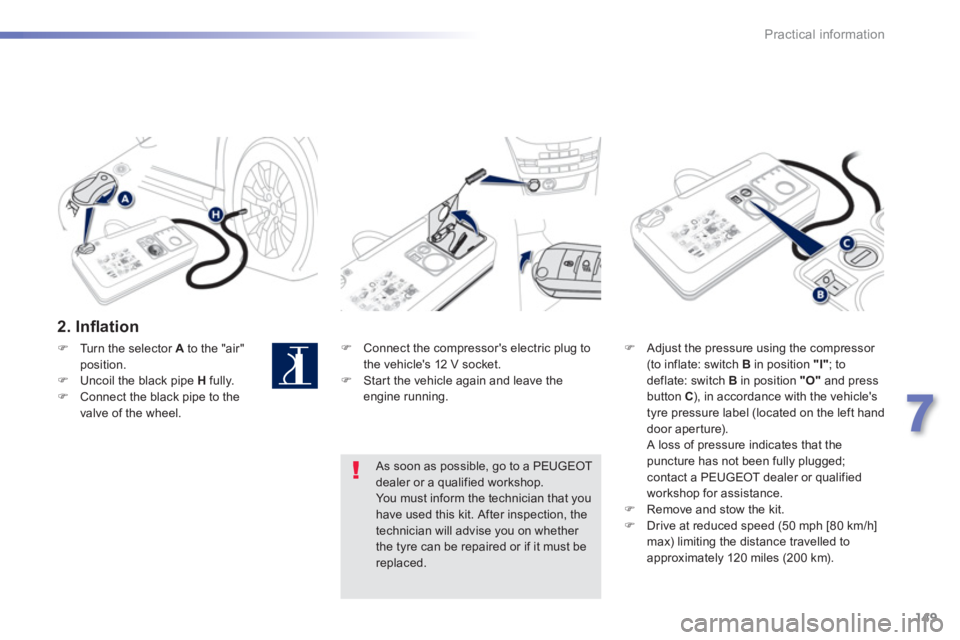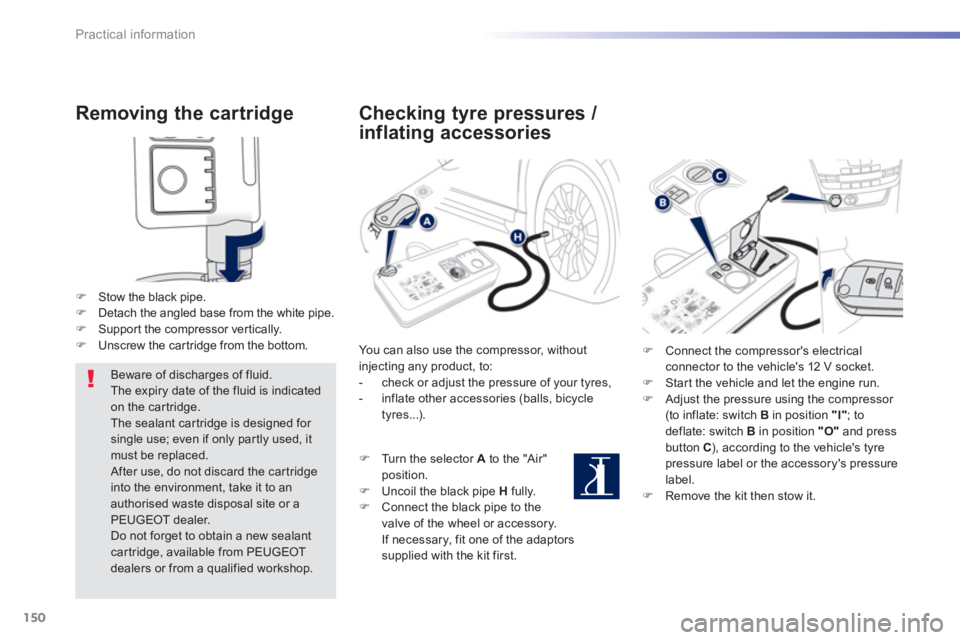2013 PEUGEOT 2008 oil pressure
[x] Cancel search: oil pressurePage 22 of 324

20
Familiarisation
Limit the causes of excess consumption
Spread loads throughout the vehicle; place the heaviest items in thebottom of the boot, as close as possible to the rear seats.
Limit the loads carried in the vehicle and reduce wind resistance (roof bars, roof rack, bicycle carrier, trailer...). Use a roof box in preference.
Remove roof bars and roof racks after use.
At the end of winter, remove snow tyres and refit your summer tyres.
Observe the recommendations on
maintenance
Check the tyre pressures regularly, when cold, referring to the label in the door aperture, driver's side. Carry out this check in par ticular:
- before a long journey,
- at each change of season,
- after a long period out of use.
Don't forget the spare wheel and the tyres on any trailer or caravan.
Have your vehicle ser viced regularly (engine oil, oil filter, air filter...) andobser ve the schedule of operations recommended by the manufacturer.
When refuelling, do not continue after the third cut-off of the nozzle toavoid any overflow.
At the wheel of your new vehicle, it is only after the first 1 800 miles (3 000 kilometres) that you will see the fuel consumption settle down toa consistent average.
Page 33 of 324

1
31
Instruments and controls
Warning / indicator lampStateCauseAction / Observations
Engine oilpressure
fixed. There is a fault with the engine
lubrication system. You must stop as soon it is safe to do so.
Park, switch off the ignition and contact a PEUGEOT
dealer or a qualified workshop.
Battery charge
fixed. The battery charging circuit has a fault (dirty or loose terminals, slack or cut alternator belt, ...). The warnin
g lamp should go off when the engine is started.
If it does not go off, contact a PEUGEOT dealer or a qualified workshop.
Door(s) open
fixed, associated with
a message identifying
the door, if the speed is
below 6 mph (10 km/h).
A door or the boot is still open. Close the door or boot.
fixed, associated with a
message identifying the
door, and accompanied
b
y an audible signal
if the speed is above
6 mph (10 km/h).
Page 151 of 324

149
7
Practical information
2. Infl ation
�)
Connect the compressor's electric plug to
the vehicle's 12 V socket.�) Star t the vehicle again and leave theengine running.
�)
Adjust the pressure using the compressor (to inflate: switch B
in position "I"
; to deflate: switch B
in position "O"and press button C), in accordance with the vehicle's
tyre pressure label (located on the left hand
door aperture).
A loss of pressure indicates that thepuncture has not been fully plugged; contact a PEUGEOT dealer or qualified
workshop for assistance. �) Remove and stow the kit. �)
Drive at reduced speed (50 mph [80 km/h]max) limiting the distance travelled to
approximately 120 miles (200 km).
As soon as possible, go to a PEUGEOTdealer or a qualified workshop.Yo u m u s t i nform the technician that you have used this kit. After inspection, the technician will advise you on whether the tyre can be repaired or if it must be replaced.
�)Turn the selector A
to the "air" position.�)Uncoil the black pipe Hfully. �)Connect the black pipe to the
valve of the wheel.
Page 152 of 324

150
Practical information
Removing the cartridge
�) Stow the black pipe.�)
Detach the angled base from the white pipe. �)
Suppor t the compressor ver tically.�)
Unscrew the car tridge from the bottom.
Beware of discharges of fluid.
The expiry date of the fluid is indicated on the car tridge.
The sealant car tridge is designed for
single use; even if only partly used, itmust be replaced. After use, do not discard the car tridge into the environment, take it to anauthorised waste disposal site or aPEUGEOT dealer.
Do not forget to obtain a new sealantcartridge, available from PEUGEOT dealers or from a qualified workshop.
Checking tyre pressures /
inflatin
g accessories
You can also use the compressor, without injecting any product, to:
- check or adjust the pressure of your tyres,
- inflate other accessories (balls, bicycle
tyres...).
�)
Turn the selector A
to the "Air"
position.
�) Uncoil the black pipe H
fully.�)
Connect the black pipe to the
valve of the wheel or accessory.
If necessary, fit one of the adaptorssupplied with the kit first.
�)Connect the compressor's electrical connector to the vehicle's 12 V socket.�)Star t the vehicle and let the engine run.�)Adjust the pressure using the compressor (to inflate: switch B in position "I"
; to deflate: switch B
in position "O"and press button C), according to the vehicle's tyrepressure label or the accessory's pressure
label. �)Remove the kit then stow it.
Page 319 of 324

.
317
Alphabetical index
ABS ...............................................................124Accessories..................................................182Accessory socket, 12V...................................72Adjusting headlamps ....................................114Adjusting head restraints................................58Adjusting seat belt height..............................129Adjusting the steering wheel ...........................60Advice on care and maintenance.................181Airbags....................................................32, 132Airbags, curtain .....................................134,135Airbags, front.........................................132,135Airbags, lateral......................................134,135Air conditioning.........................................14,19Air conditioning, digital..................14, 64,67,70Air conditioning, manual...............14, 64,65,70Air distribution adjustment........................66, 69Air filter..........................................................r196Air flow............................................................19Air flow adjustment ...................................66, 69Air intake...................................................66, 69Air recirculation.........................................66, 69Air vents ..........................................................63Alarm...............................................................51Anti-lock braking system (ABS)....................124Anti-theft..........................................................47ASR...............................................................124Assistance, emergency braking...................124Assistance call ......................................123, 208Audible warning............................................123Audio cable..................................244, 279, 305Audio streaming (Bluetooth).................243, 280Audio system (radio)....................236, 272, 298Automatic illumination of headlamps....108,113Automatic operation of hazard warninglamps..........................................................122Automatic rain sensitive windscreen
wipers .................................................116, 118Auxiliary sockets............73, 240, 244, 279,305
Capacity, fuel tank ........................................188CD.................................................240, 275, 301CD MP3........................................240, 276, 302Central locking..........................................44, 45Changing a bulb.....................................159-165Changing a fuse.....................................166-171Changing a wheel ..................................151-159Changing a wiper blade........................119, 176Changing the date...........................................43Changing the remote control battery..............49Changing the time...........................................43Checking levels......................................193-195Checking the engine oil level ..................37, 193Checking tyre pressures (using the kit)........150Checks...................................................185-197Child lock .......................................................144Children..........................................131, 13 6 -14 4Child seats ............................................136-143Child seats, conventional ..............................138Cleaning (advice)..........................................181Closing the boot..............................................55Closing the doors ............................................45Colour screen................................................212Connectors, audio..........73, 240, 244, 279,305
AB
C
Coolant level ...........................................33,194Coolant temperature indicator........................r33Courtesy lamps.............................................120Cruise control..........................................98,100Cup holder.......................................................r71
Battery............................................172-174,196Battery, charging...................................173, 174Battery, remote control.............................49, 50Bluetooth (hands-free)..........................250,281Bluetooth (telephone)............................250, 281Bonnet...........................................................185Bonnet stay ...................................................185Boot.................................................................55Brake discs....................................................197Brake lamps ..........................................163, 164Brake pads....................................................197Date (setting)...................................................43Daytime running lamps.................................111Deactivating the passenger airbag ...............133Defrosting ........................................................70Demisting........................................................70Diesel additive level......................................195Dimensions ...................................................205Dipped beam.........................................107,160Dipstick ....................................................37,193Directional lighting ........................................115Direction indicators......................112, 122, 159,
160, 163,16 4
Door pockets ...................................................71Driving economically.......................................19Dynamic stability control (DSC) ...27,29, 124, 126
D
EBA (Emergency braking assistance) ..........124EBFD.............................................................124Eco-driving......................................................19Economy mode.............................................175Electric window controls.................................53Electronic brake force distribution (EBFD)...124Electronic engine immobiliser...................r47, 50Emergency boot release.................................55Emergency call.....................................123, 208
E